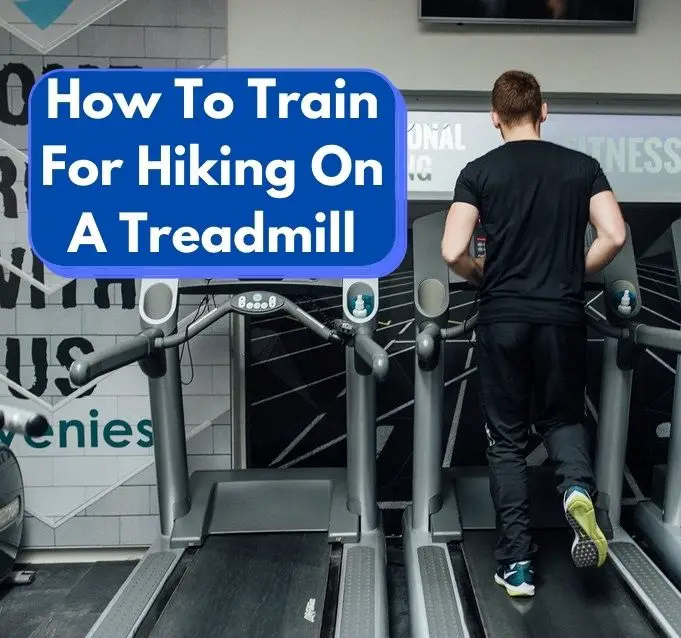If you’re looking to get started on hiking or improve your fitness level to get more out of your time on the trail, knowing how to train for hiking on a treadmill can be a great way to level up your skills from the comfort of your home.
Treadmills are often used in training for hiking, but you have to use them properly to make sure your time is well spent.
We’ll cover 3 great treadmill workouts for hiking below in this guide.

General Treadmill Hiking Training Tips
If you’re new to working out on a treadmill, begin slowly and be sure you know how the treadmill controls work. Always wear the safety key.
Try to leave your hands free rather than gripping the treadmill’s handles, as this decreases your heart rate and doesn’t simulate your arms’ natural movement when walking or hiking
Benefits Of Hiking Training On A Treadmill
Training for hiking on treadmills can help to:
- Increase your aerobic endurance (for hiking long distances)
- Increase your lactate threshold (which lets you hike for higher intensities before discomfort sets in)
- Increase your VO2 max interval (allowing you to hike at higher elevations without lightheadedness)
We’ll go over some great workout options below to train for these specific goals.

3 Workouts To Train For Hiking On A Treadmill
Hill Training Treadmill Hiking Workout
Duration: 30-75 minutes
Equipment: Treadmill, Weighted Hiking Backpack (optional)
If you’re planning some hikes that involve steep inclines, this hill training workout is a great way to prepare your body for the challenge ahead.
- Warm up on the treadmill at a speed between 2.5-4mph
- Set the incline between 12-15 percent, keeping the same speed
- Continue this workout for 30-75 minutes
Keep focus on your stride and make sure you position your torso as upright as possible, which will help you to access your hiking muscles (lower back, core, glutes, and hamstrings) while elevating your heart rate for some great cardio.
Throw on your hiking backpack with your typical gear in it too for added benefit, as this will get you as close to the real thing as possible.
Lower Leg Strength Treadmill Hiking Workout
Duration: 45-60 minutes
Equipment: Treadmill, Dumbbells (optional), Jump Rope (optional)
If you notice a lot of pain or soreness in your calves after hiking, this workout is for you.
Traversing declines is much easier on your glutes and hamstrings, but your calves and ankles are doing a lot of work on the way back down the hill after a long day of hiking.
This workout will help strengthen those muscles and prevent injury.
- Start with 10 minutes on the treadmill at a warmup speed (either at no incline or slight incline)
- Get off your treadmill and perform 10-20 single-toe hops, making sure to stay off your heels. You can do this with or without a jump rope.
- Do 10-20 calf raises with or without dumbbells (you can eventually start using dumb bells or increase the weight over time to build up your calf muscles)
- Repeat this cycle 3 to 4 times
Aerobic & Endurance Treadmill Hiking Workout
Duration: 60 minutes
Equipment: Treadmill, Weighted Hiking Backpack (optional)
Your aerobic endurance is one of the most important fitness aspects that hikers can build, and that’s done through combining low-intensity work over long periods.
- Load up your hiking backpack with your usual amount of hiking gear (or start with less and gradually work your way up to a full load)
- Start walking on your treadmill at a moderate pace at no incline
- Increase the incline by 1-2 percent every 2 minutes
- Once you reach the max incline, start decreasing the incline every 1-2 minutes by 1-2 percent
- Repeat this process for 60 minutes
Additional Treadmill Hiking Training Moves To Try
Side Shuffles To Backwards Walking
- Set the treadmill at 2mph or less, walking forward for one minute, then turning sideways and shuffle for one minute (using the handrail for balance if needed).
- Turn again and walk backwards on the treadmill for one minute, turn the other direction, and shuffle for another minute.
- Continue for 20-30 minutes, increasing the speed or incline over time as your comfort level allows
Uphill Lunges
- Set the treadmill at 1mph and the incline at 5 percent.
- Instead of walking, do lunges instead, making sure to drop your knee back down in a straight line, then stand up and repeat with the other leg.
- Perform lunges on alternating legs for 1-2 minutes.
- Alternate with periods of normal walking for 3-4 minutes.
- Repeat the lunge and walk cycles for a total of 20-30 minutes.

3 Ways To Train For Hiking On A Treadmill
There are three main ways you can use a treadmill to train for hiking, which we’ll cover in-depth below.
We’ll cover each of these in-depth below.
Use The Treadmill’s Incline option to simulate hiking up hills
Most hiking trails have a max incline of 10%, so you can set your treadmill between 8-12% to effectively train for uphill hiking.
You can also use this feature to train for hiking a total elevation if you have a goal or specific trail in mind (more on that below).
Supplement Your Hiking With A Treadmill For Total Distance
If you have a distance or total elevation goal in mind, your schedule may not always work out to where you can complete it entirely through hiking outdoors.
If this is the case, you can use the treadmill to round out the rest of your distance you didn’t cover on the trail and still achieve your objective.
Use Your Treadmill As An Alternative When You Can’t Hike Outdoors
If the weather or other obligations in your life won’t allow you to make it outdoors to go hiking, using the treadmill is a good alternative that won’t require as much preparation (or travel time).
Although a treadmill is no replacement for hiking, it does a great job in a pinch.
How To Calculate Elevation Gain On A Treadmill
Step 1: Take your treadmill’s incline setting (6 in this example) and divide by 100 (6/100 = .06)
Step 2: Multiply that number by the amount of miles you walked on your treadmill (let’s suppose you walked 3 miles), so .06×3 = .18
Step 3: Convert that to feet by multiplying your answer by 5,280 (.18mi x 5280 = 950.4ft)
Step 4: Convert to meters (if desired) by dividing your answer by 3.281 (950.4/3.281 = 289.67m)
So in the above example, if you walked for 3 miles on a treadmill set at 6% incline, you hiked an elevation of about 950ft or 290m!
Other Ways To Train For Hiking At Home
Check out our guides on 6 exercises to give you explosive power for hiking uphill and how to strengthen and prepare your knees for hiking for some great tips on how to get your body in excellent shape for hiking.
FAQs About Treadmill Hiking Training
It is not recommended to wear hiking boots on a treadmill because the lugs on the bottom of hiking boots can damage the treadmill belt.

